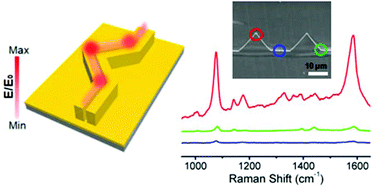3D zig-zag nanogaps based on nanoskiving for plasmonic nanofocusing†
Abstract
We combine anisotropic wet etching and nanoskiving to create a novel three-dimensional (3D) nanoantenna for plasmonic nanofocusing, vertically aligned zig-zag nanogaps, constituted of nanogaps with defined angles. Instead of conventional lithography, we used the thickness of a self-assembled monolayer (SAM) to define nanogaps with high throughput, and anisotropic etching of Si V-grooves to naturally define ultra-sharp tips. Both nanogaps and sharp tips can synergistically squeeze the electro-magnetic (EM) field and excite 3D nanofocusing, enabling great potential applications in chemical sensing and plasmonic devices. The dependence of the EM field enhancement on structural features is systematically investigated and optimized. We found that the field enhancement and confinement are stronger at the tipped-nanogap compared to what standalone tips or nanogaps produce. The intensity of surface-enhanced Raman spectroscopy (SERS) recorded on the 70.5° tipped-nanogaps is 45 times higher than that recorded with linear nanogaps and 5 times higher than that recorded with tip-only nanowires, which is attributed to the integration of the tip and gap in plasmonic nanostructures. This proposed nanofabrication technique and the resulting structures equipped with a strongly enhanced EM field will promote broad applications for nanophotonics and surface-enhanced spectroscopy.



 Please wait while we load your content...
Please wait while we load your content...